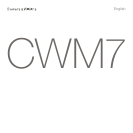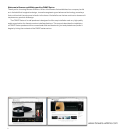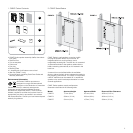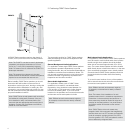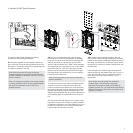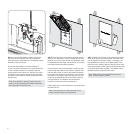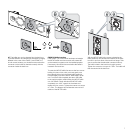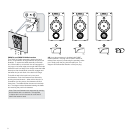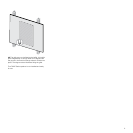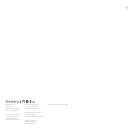
5
4. Installing CWM7 Series Speakers
To install a CWM7 Series speaker proceed as
described in the following paragraphs:
4.1 Using the supplied cut-out template, mark a cut
line on the wall. Check the cut line denes the correct
dimensions. Cut along the line with an appropriate tool
to create an aperture in the wall.
Note: Ensure that there is enough free space
internally adjacent to the aperture for the back box
clamps to rotate fully outwards. 20mm (0.79 in) free
space is required.
Note: To reduce the possibility of the ceiling buzzing
or rattling, adhesive mastic can be applied between
the studs and sheetrock in the vicinity of the
speaker aperture.
4.2 The reservoir box enhances the low frequency
performance of CWM7 Series speakers. It connects
to the top or bottom of the back box via a hinge and
clamp that enables it to be fed into the wall cavity
above or below the back box. CWM7 Series speakers
are shipped set up for the reservoir box to be installed
below the back box. If this is not practical, perhaps
thanks to the encroachment of drywall frame noggin
(horizontal brace), the reservoir box can be swapped
for use above the back box.
Note: An arrow symbol on the back box illustrates
upward orientation.
To swap the reservoir box location, the blanking plate
screwed to the lower inside panel of the back box
must be unscrewed and replaced to cover the hole in
the upper inside panel. Ensure that the thumb screws
securing the blanking plate are adequately tight. The
diagram above illustrates the removal and replacement
of the blanking plate and attachment of the reservoir
box.
We recommend that the reservoir box is always used
if possible, however with a CWM7.3 speaker installed
in landscape orientation, use of the reservoir box is not
possible. If no reservoir box is used a blanking plate
must be tted to both back box holes.
4.3 If speaker cable is already present in the wall
space, pull the cable through the aperture. If speaker
cables are not already installed this should be done at
this stage. It is likely that you will need to gain access
through the oor above to route the cables down into
the wall cavity.
Leave enough spare cable through the aperture to
ease connection to the speaker back box, but not so
much that it is likely to buzz or rattle when pushed
back up into the cavity. Approximately 1.0m is
appropriate.
Note: Always use high quality, low resistance
speaker cable. Low resistance is especially
important if the length of cable from amplier to
speaker exceeds 5m. Your local Bowers and Wilkins
retailer will be able to offer advice on speaker cable
selection if required.



